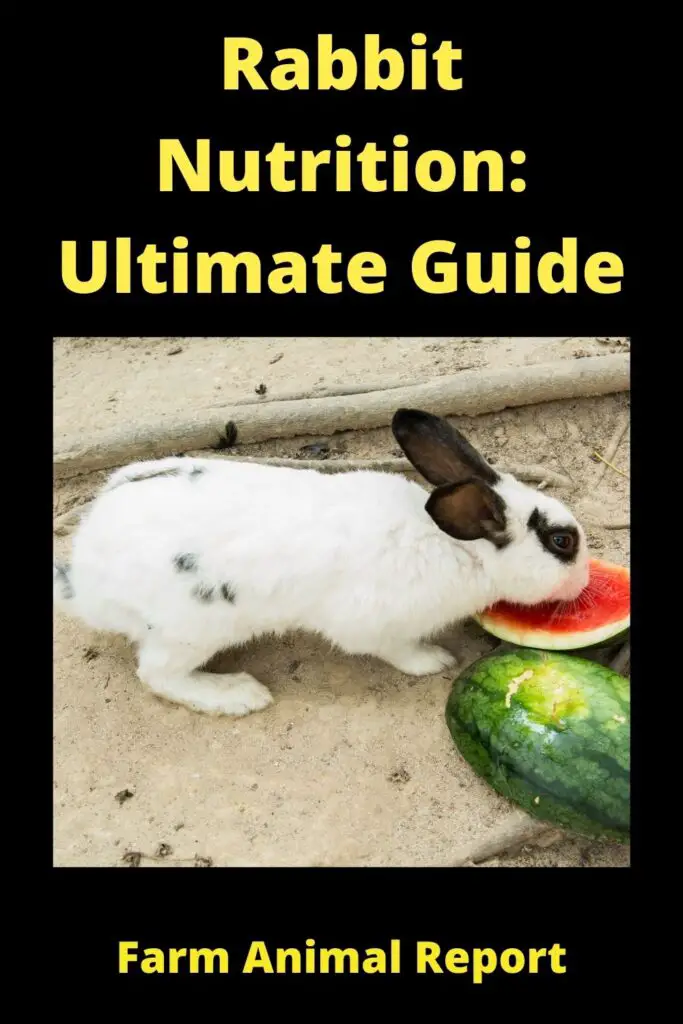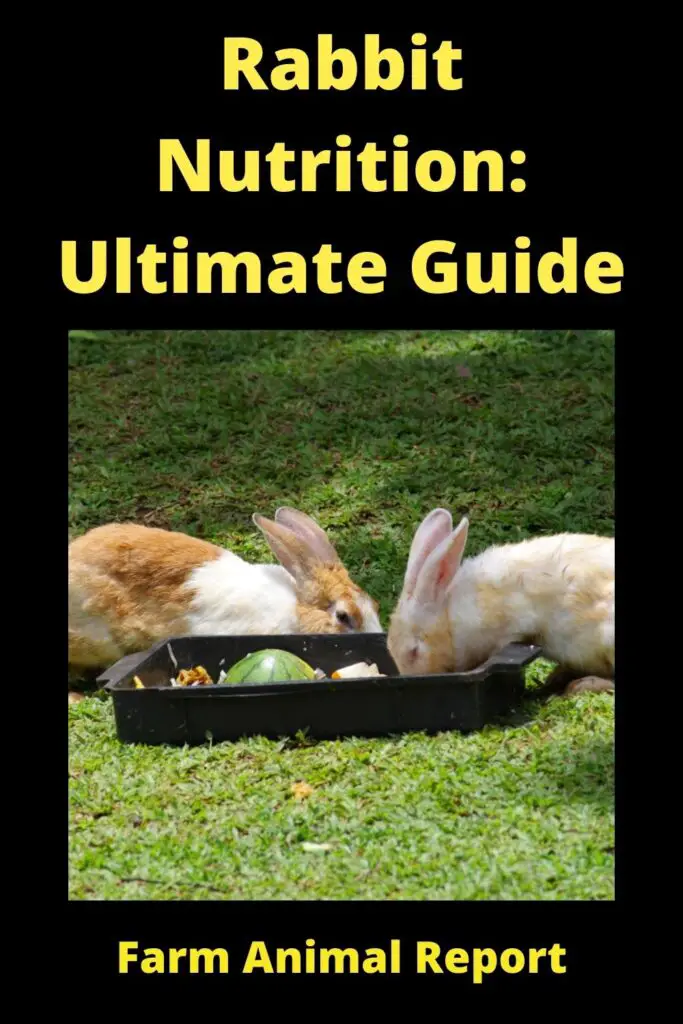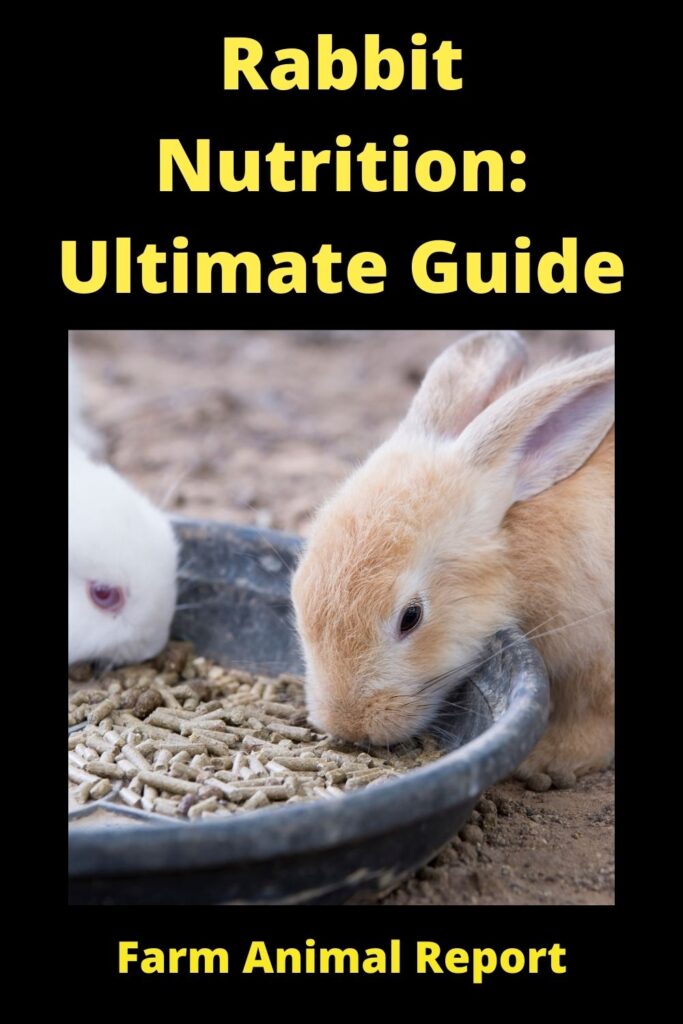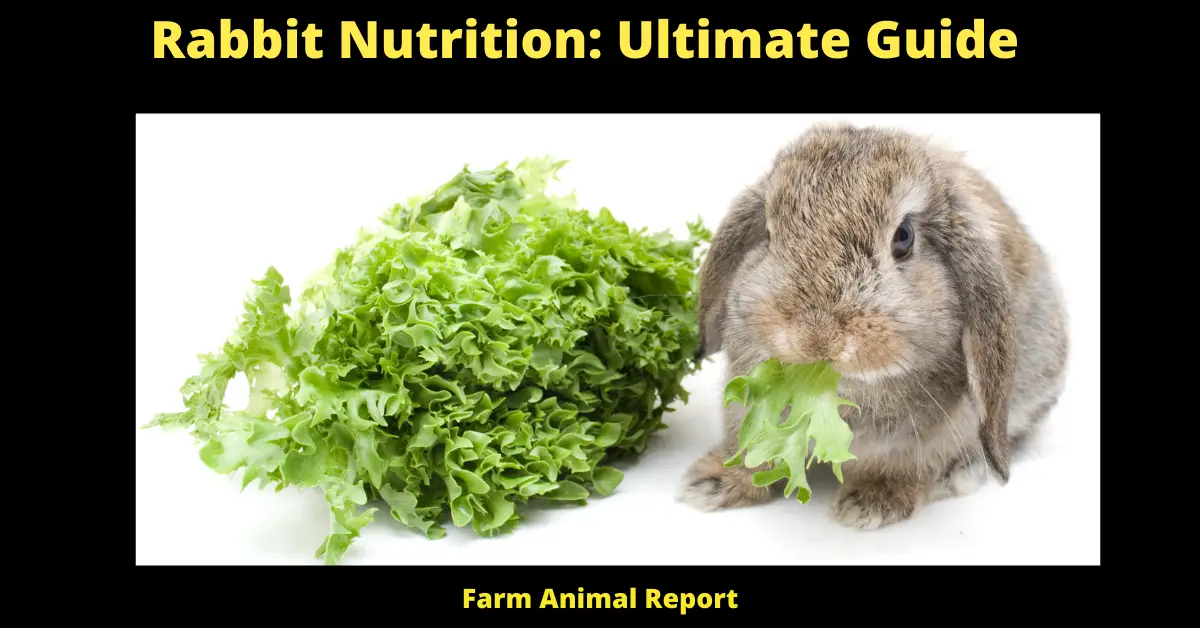Rabbit Nutrition
As a General Rule – A rabbit’s digestive system needs hay or grass to function properly so a healthy supply is extremely important. You can supplement with leafy greens and pellets, but it’s best not to feed your bunny any kind of dry food – they don’t have enough moisture in their diet for this!
What do rabbits eat? Their natural diet consists of grass hay, fresh water, and leafy vegetables. However, many pet rabbits have their diets severely limited or are fed entirely inappropriate foods because so much misinformation is circulated about what to feed them.
Rabbit Nutrition – You may have wondered how you should go about feeding your rabbit correctly? If so, you are not alone. The majority of rabbit keepers believe that the key to keeping a happy and healthy rabbit is a diet consisting primarily of fresh vegetables, with some hay or commercial pellets as an optional addition. While this is certainly one viable option, it is not the only one.
In captivity, rabbits can be fed many things – from processed foods bought at the supermarket to foods composed of nothing but rabbit droppings.
A few years ago, it was written on this website that rabbits should not be fed any fruit or vegetables because these could promote gut stasis. This was due to the wording of certain popular books at the time. That statement is no longer valid now that it has been discovered that the opposite is true.
Lactating females and babies up to six months of age may need more energy than they can get from hay and grass. In these cases, low-sugar vegetables such as carrot tops, beet greens, or Swiss chard leaves make a nutritious addition to the diet. Summer squash and zucchini also contain less sugar than other vegetables.
18 Ways to Make Money by Rabbit Farming—Extensive Guidelines for Rabbit Farmers
Rabbit Nutrition – The Science
The rabbit digestive system is somewhat unique in that it can adapt easily to changes in diet. The key to the success of the rabbit as a laboratory animal, pet, and food source lies within this fact. The well-being of rabbits can be maintained through nutritional balance by keeping important dietary components constant over time. The rabbit’s ability to adapt to nutritional shifts makes it an ideal research animal for testing the components of new diets. The adaptability also reduces wastage because rabbits will eat most things.

Rabbit Digestive System
The digestive system of the rabbit is quite complex and is divided into 2 segments;
Rabbit Gastrointestinal Tract (GIT)
the gastrointestinal tract (GIT) and the cecum or large intestine (CLI). The GIT is further divided into the mouth, esophagus, stomach, small intestine, and large intestine.
Rabbit Cecum / Large Intestine / (CLI)
The cecum is composed of 3 sections: The proventriculus or fore-stomach, the gizzard, and the ileum or hindgut. The majority of digestion occurs in the GIT as food is broken down into its smallest components. The material then enters the cecum where certain food elements are digested by microflora which lives in the gut. The undigestible portions, also known as fiber or roughage, are stored within the CLI for later expulsion through the anus. The function of the cecum is similar to the rumen of cattle. The rabbit’s adaptability is due to the different areas of the GIT having varying pH levels which are optimal for various digestive processes.
Best Greens for Rabbits
Rabbits are vegetarians, so it’s important to provide them with plenty of greens. Greens are not only healthy for your rabbit, but they also help relieve boredom and keep teeth trimmed. The following list contains the best greens you can offer your bunny. However, these should be fed in moderation, because although very nutritious, they can also lead to diarrhea if fed in excess.
1. Bok Choy
The leaves of this Chinese cabbage are packed with nutrients. You can feed your bunny the whole plant or just give him/her the leaves. The stems are too tough for rabbits to eat, so you should remove them before giving this green to your pet.
2. Carrot Tops
These greens are easy to find at farmer’s markets or grocery stores that sell organic produce. If you pick up a bunch of carrots, just throw the green tops into your rabbit’s cage. They’ll be more than happy to eat them!

3. Lettuce
If you only give your pet one green to eat, then lettuce should be it. Romaine and Iceberg are the best types of leafy green lettuce to feed your bunny. While adult rabbits can eat this plant without any problems, younger animals should not be given too much as it may cause diarrhea.
4. Mint
This herb is extremely popular with rabbits. You can purchase a small plant and grow it at home, or simply buy a bunch from the supermarket and add it to your bunny’s cage.
5. Clover
This type of herb makes for a great treat because rabbits love eating it! Before giving either of these greens to your pet, make sure you give them a good rinse.
6. Cilantro
This is one of the most nutritious greens you can offer your bunny, although it’s not as popular as the others on this list. Cilantro contains antioxidants and minerals your rabbit needs to stay healthy. However, because too much cilantro can cause gas in some rabbits, only feed your pet a small amount at first.
7. Radish Tops
These greens are ideal for rabbits of all ages, and they’re packed with nutrients. You can pretty much give them these greens in unlimited quantities! They also make a great salad ingredient. Just make sure you remove the leaves from the stems before feeding them to your bunny.
8. Endive
This is a good green for young bunnies, but it should be fed sparingly to mature animals due to its high calcium content. Endive can be given raw or cooked with most meals and is also a great addition to salads.
What Vegetables can rabbits eat daily?
The vegetable is good for rabbits’ health. Many kinds of vegetables can be eaten by rabbits. Besides being tasty, vegetables also provide useful supplements that are not supplied in the feed. Vegetables give fiber, minerals, vitamins, and are helpful for digestion. Vegetables are also safe because they are more difficult to cause poisoning compared with fruits.
What Weeds Can Rabbits Eat
Rabbits are animals that love to eat. They feed on the foliage of every sort and often can be found in pastures or crop fields chomping away on the grasses growing there. If the rabbit is shelterless then they will naturally gravitate towards any plant growth that they can feed upon, including weeds.
- Dandelions Greens
- Clover * Mint * Violets * Chickweed * Plantain * Curly Dock Leaves
- Comfrey
- Mint can be toxic in high doses
What Weeds Can Rabbits Not Eat?
In a perfect world, rabbits would be able to eat all the weeds in your garden. In reality, though, there are several types of plants that can harm or even kill your rabbit. Always err on the side of caution and keep these dangerous plants out of reach:
* Horehound leaves
* Nightshade berries
* White Clover
* Yarrow
Hay for Rabbits
What do rabbits like to eat? Hay. If you’ve got plenty of hay, you’re probably doing pretty well by your rabbit. Lots of veggies and some pellets will make him happy too, but it’s the hay that is important for his health. You can’t give enough hay!
It takes a lot of energy for a rabbit to chew. If he doesn’t have a good supply of hay, he will eat his poop and even his bedding to get the fiber that he needs. Poop is not food! Give him enough hay and you won’t have this problem.
When you’re buying hay, browse through it to make sure that there are no brown or yellow pieces. These will not be as healthy for your rabbit as the bright green is. Stems should be stiff enough to bounce back up when you push on them with your hand. Look for pesticide-free stuff too. Hay can become contaminated with some pretty nasty chemicals if the plants are grown near commercial farms.
Timothy Hay for Rabbits
Timothy hay has long been recognized as an essential part of a healthy diet for rabbits. Unfortunately, not all brands are the same and many hay products lack the nutritional balance that makes timothy such a valuable feed. To help you choose what to buy, we’ve investigated the analysis (and the analysis isn’t always on the label) and come up with a few guidelines to help you choose hay that will help your rabbit live a longer, healthier life.
Alpha Hay for Rabbits
The newest miracle product on the market is Alpha Hay, hay available exclusively from Metaphor. Studies show that this new kind of hay can keep rabbits healthier and more active than ever!
Alpha Hay is grown in different climates and combines to give bunnies all they need out of their food throughout the year. The first ingredient is Timothy Hay, the classic hay Americans have trusted for years as a good source of fiber. To that is added alfalfa, dandelion, and watercress to give it a fresh taste and vitamins.
For those who already supplement hay with fruits and vegetables, this new all-natural product is going to be a godsend! Not only is Alpha Hay senior and baby bunny safe, but it seems to be full of the nutrition bunnies need.
- Timothy Hay – Consist of soft stems perfect for harvesting your own.
- Alfalfa Hay – Contains more calcium than any other hay, making it the best choice for young rabbits or those with sensitive stomachs. Newborns should be fed alfalfa hay until they are two weeks old; after that time, you can switch to timothy.
- • Meadow Hay – Meadow Hay consists of wild-growing meadow grasses. This hay usually consists of around 50% fiber, 26% protein, 5% fat, and 8% moisture.
- • Orchard Grass – The name says it all! Orchardgrass is that stuff they use to feed grazing animals at zoos so you know it’s good for bunnies.
- • Oat Hay – Oat hay is made from young, green oats harvested when the plant is just beginning to flower. The carbohydrate content of oat hay makes it a good choice for grass-eating animals such as rabbits and horses, but it’s still high in fiber and protein to support healthy digestive systems.
- • Rye Grass – Ryegrass is great, nutritious hay. However, it’s important to be careful when offering this product to rabbits. In large quantities, this type of hay may cause bloat in rabbits because of its high starch content.
- • Oat Hay – consist of more carbohydrate than any other hay, making it the best choice for young rabbits or those with sensitive stomachs. Newborns should be fed oat hay until they are two weeks old; after that time, you can switch to timothy.
- • Herbal Hay (Herbage) – consists of a variety of dried herbs. When you purchase herbal hay, be careful to read the label so that you know exactly what’s in it.

Types of Grass for Rabbits
Rabbits naturally graze on grass, preferring the young, tender blades near the top of the plant. So what does that mean for your pet? You can give them a “salad” made from fresh grasses to add variety and nutrients to their diet.
Be careful with grass clippings from lawns that have been treated with fertilizers. Some types of fertilizer can be dangerous to your rabbit, so cut away about an inch or two of grass before giving it to them to play with.
• Wheatgrass – Young shoots taken from the wheat plant. An excellent source of fiber and chlorophyll; good for building blood counts.
• Timothy Grass – This is the most common type of grass hay. • Orchard Grass – Contains more calcium than any other hay, making it the best choice for young rabbits or those with sensitive stomachs. Newborns should be fed orchardgrass until they are two weeks old; after that time, you can switch to timothy.
• Meadow Grass – A wild-growing meadow grasses. This hay usually consists of around 50% fiber, 26% protein, 5% fat, and 8% moisture.
• Oat Hay – consist of more carbohydrate than any other hay, making it the best choice for young rabbits or those with sensitive stomachs. Newborns should be fed oat hay until they are two weeks old; after that time, you can switch to timothy.
• Brome Grass – Consist of very fine stems, excellent for making into hay or straw bales. Highly nutritious with a good balance of fiber and protein.
• Orchard Grass – Contains more calcium than any other hay, making it the best choice for young rabbits or those with sensitive stomachs. Newborns should be fed orchardgrass until they are two weeks old; after that time, you can switch to timothy.
• Bermuda Grass – Contains more calcium than any other hay, making it the best choice for young rabbits or those with sensitive stomachs. Newborns should be fed bermuda grass until they are two weeks old; after that time, you can switch to Timothy Hay.
Rabbit Nutritional Pellets
Rabbit pellets contain the correct balance of nutrients to meet a rabbit’s dietary needs when fed as the primary source of nutrition. The pellet should not be more than 10-12% of the diet because feeding high-carbohydrate diets promote obesity and may predispose rabbits to develop “furballs.”
Rabbit pellets are an excellent, convenient way to feed your rabbit. However, they are not a complete diet. Calcium deficiencies may develop if the pellet is too high in carbohydrates or if an herbivore is fed only pellets. Hay, grass hays (i.e., timothy), fresh vegetables, and some seeds should make up roughly 80% of your pet rabbit’s diet.
Rabbit owners should look for a pellet that is between 16 and 18 percent crude fiber. A high fiber diet results in reduced fecal output and less intestinal gas.
Rabbit pellets should be fresh. Avoid buying rabbit pellets from the bulk section of the feed store since these may be rancid, and/or contaminated with rodenticides (rat poison). For the same reason, avoid buying rabbit food from pet stores that do not have a high turnover on their inventory.
1. What percentage of the diet should be made up of pellets?
The dietary needs of bunnies can be met with a pellet that is between 16 and 18 percent crude fiber.
2. Are there any harmful effects to a rabbit eating a diet that is too low in fiber?
If the pellet is less than 16 percent crude fiber, there can be negative effects on the intestinal tracts. This would also cause an increase in fecal output and intestinal gasses.
3. Are there any additional benefits for this pellet to be fresh?
Yes! If the pellets are fresh, it will help to decrease the likelihood of intestinal gasses because there is a higher content of fiber.
4. What should you look for when purchasing pellets?
Room temperature pellet storage bins are best for maintaining freshness and quality. So if you’re getting your rabbit food from the bulk section of the feed store, try to find an owner that buys their pellets in smaller quantities and tries to sell them as often as possible.
Clean Fresh Water – Importance
A rabbit’s water intake is very closely monitored by the veterinarian due to their sensitivity to impurities, infections, and resulting death. A large number of diseases in rabbits are related to water balance which affects the kidneys – if not corrected can lead to uremic poisoning or even death. Clean fresh water should always be available for your rabbit.
Rabbits obtain their water from their food and can be selective in choosing which foods they will consume.
A rabbit’s body is approximately made up of 70% water, so it is essential to maintain hydration by offering fresh clean water at all times.
Fresh, cool water should be available at all times; ice cubes can be offered as needed.
Water consumption varies between each rabbit but it is important to ensure that they are drinking enough water to keep their bodies well hydrated.
Final Thoughts
Rabbit nutrition is surprisingly simple. Rabbit food includes any non-toxic plant matter that the animal can eat. This includes hay, grasses, root vegetables, and fruit. It does not include things like grain or legumes. How much you feed your rabbit depends on its age and what it is being fed. A mother nursing her young, for instance, will need to eat more than a senior bunny whose days of top-speed running are over. It is best not to take modern food items and feed them to your rabbit. It will get sick and die if you do this.





